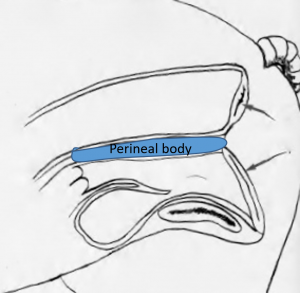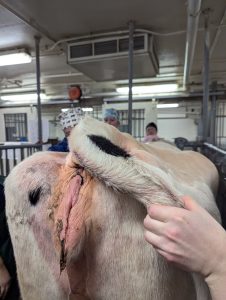Female urogenital surgery
How to – Perineal body transection
Indications
Perineal body transection is performed for severe splanchnoptosis and for mild cases of urine pooling.
Relevant anatomy
The perineal body is located between the dorsal vagina and the rectal floor. It is comprised of sphincter muscles that create tone for the vestibule, help maintain the vestibular sphincter, and also connects the vaginal vault to the rectum and viscera (this isn’t always helpful).

Preoperative management
Food restrictions: NA
NSAIDs/analgesics: Preoperative NSAID recommended
Antibiotics: NA
Tetanus prophylaxis is recommended.
Local blocks: Line block or epidural
Position/preparation: Standing procedure. The rectum should be emptied prior to surgery. The area is cleaned and blocked. Surgeon should be gloved.
Surgery Supplies:
- Scalpel blade and handle
- Towel clamps
Surgical procedure
A towel clamp is hung on the dorsal aspect of the vulva. A 4-6 cm inverted U incision is made between the rectum and vagina. Sharp scalpel dissection is carried forward until the vulva is vertical. Slight additional dissection may be helpful to minimize the effect of scar tissue formation during healing.

The towel clamp is removed and the area left open for second intention healing.
Postoperative care
- Clean the wound daily until epithelialized. Healing is typically rapid.

Complications
- Very extensive surgical dissection could enter the peritoneal cavity but this would be difficult as the peritoneal reflection is approximately 12″ deep
Videos
Resources

